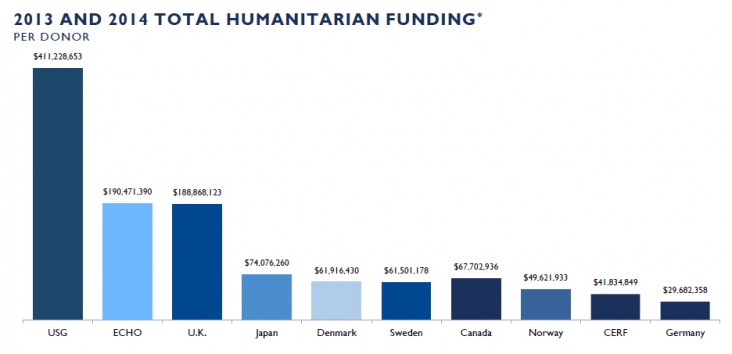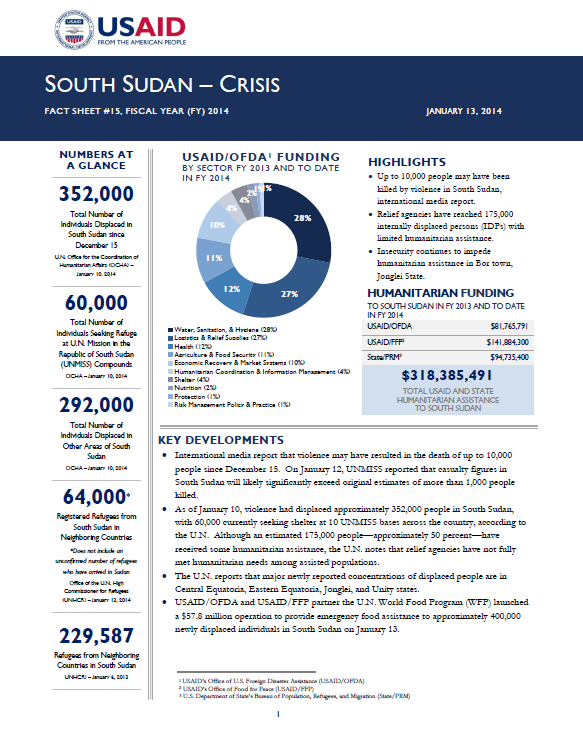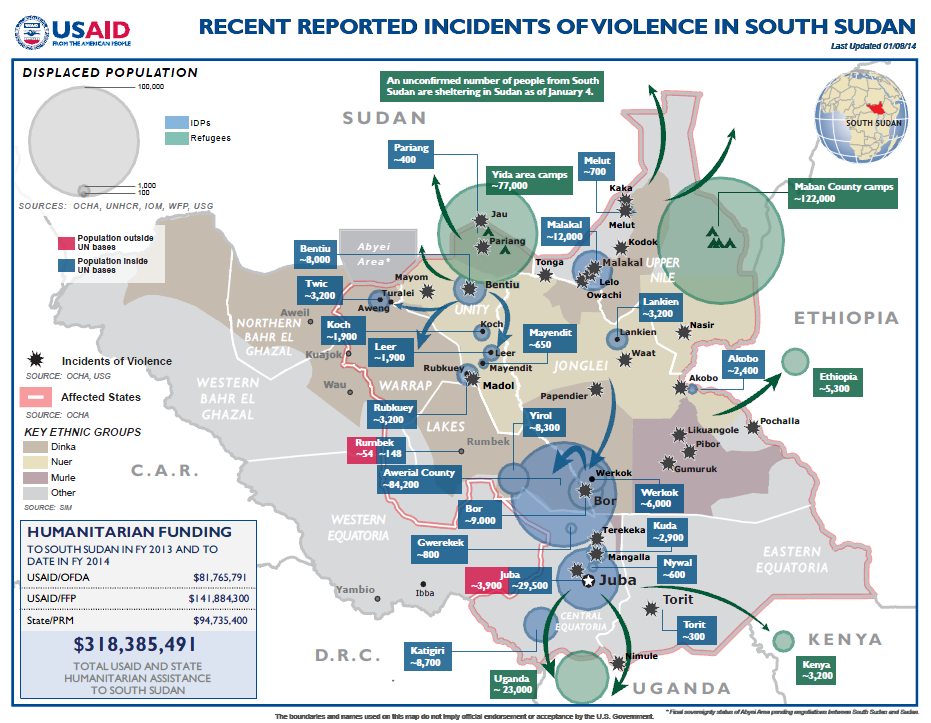- What We Do
- Agriculture and Food Security
- Democracy, Human Rights and Governance
- Economic Growth and Trade
- Education
- Environment and Global Climate Change
- Gender Equality and Women's Empowerment
- Global Health
- Humanitarian Assistance
- Transformation at USAID
- Water and Sanitation
- Working in Crises and Conflict
- U.S. Global Development Lab
Speeches Shim
February 18, 2014
Numbers At A Glance
716,100
75,300
640,800
156,800
231,600
Humanitarian Funding:
To South Sudan To Date In FY2013 and FY2014:
| USAID/OFDA | $87,174,812 |
| USAID/FFP | $141,884,300 |
| State/PRMDoD | $94,735,400 |
| TOTAL | $323,794,512 |
Highlights
Violent clashes resume in Upper Nile State’s capital of Malakal town.
Humanitarian access remains constrained in Unity State as insecurity and attacks against aid workers continue.
Relief agencies expand efforts to pre-position food rations and critical supplies prior to April-to-August rainy season.
KEY DEVELOPMENTS
Fighting has resulted in increased population displacement in recent days, with violence displacing nearly 873,000 people—including both internally displaced persons (IDPs) and refugees fleeing to neighboring countries—since December 15, according to the U.N.
Unpredictable security conditions continue to impede consistent, robust humanitarian operations, particularly in conflict-affected areas of Jonglei, Unity, and Upper Nile states. Many displaced people are sheltering in remote areas widely dispersed across large portions of the country, while persistent fighting and increased criminality continue to compound difficulties for providing sustained assistance.
Logistical challenges have also impeded relief efforts. On February 14, a cargo plane chartered by the International Organization for Migration (IOM) crashed upon landing in Bentiu town, Unity, resulting in one death and multiple injuries among crew members. Prior to the crash, IOM-chartered flights had facilitated the delivery of approximately 154 metric tons (MT) of relief commodities to communities in Jonglei, Unity, and Upper Nile.
Despite access constraints, relief agencies are increasing efforts to coordinate humanitarian response activities for displaced populations and expand response efforts where possible, providing limited humanitarian support for approximately 302,500 people as of February 17. Relief organizations are focusing efforts on pre-positioning of food supplies and relief commodities prior to the upcoming April-to-August rainy season, which will likely impede humanitarian access to populations in need through October.
SITUATION, DISPLACEMENT, AND HUMANITARIAN NEEDS UPDATE
Insecurity continues to affect communities and impede humanitarian access in parts of Jonglei, Unity, and Upper Nile, with renewed clashes between Government of the Republic of South Sudan (RSS) forces and opposition groups reportedly erupting in Malakal town on February 18. As of February 17, the highest concentrations of displaced populations countrywide were located in Unity, with approximately 198,300 IDPs, and Jonglei, with an estimated 129,600 people displaced.
Fighting in and near Malakal could displace additional populations to the local UNMISS base, where more than 21,500 IDPs were sheltering prior to the recent outbreak of violence. Relief agencies have expressed concern that additional displacement to the UNMISS compound in Malakal could result in overcrowding, increased humanitarian needs, and heightened tensions among IDPs. In recent days, an interagency team estimated that up to 10,000 people fled to Rom town—located approximately 80 kilometers (km) north of Malakal—in anticipation of imminent violence in the town.
Insecurity continues to affect communities in central and southern areas of Unity, with unconfirmed reports indicating clashes occurring in Guit and Koch counties on February 16. Relief agencies are also working to confirm reports that approximately 45,000 IDPs have fled from severely conflict-affected areas to Ganylel and Nyal towns, Panyijiar County. Meanwhile, armed elements reportedly attacked a convoy of vehicles carrying aid supplies on the road connecting Yida and Mayom towns and abducted three contractors during the week of February 10, which could further impede access to remote areas and refugee populations.
Tensions have increased in Abyei Area following attacks reportedly conducted by the Sudan People’s Liberation Army (SPLA) and RSS police forces on February 3, as well as due to recent intra-communal fighting, according to the U.N. On February 14, the U.N. condemned the attack and urged all RSS security forces to withdraw from the area. Approximately 2,600 people have fled to Abyei due to hostilities in South Sudan since December 15.
The USAID-funded Famine Early Warning Systems Network (FEWS NET) reports that violence in South Sudan—and resulting population displacement, disruption of trade, and anticipated below-average harvest yields—could result in the early onset of the upcoming lean season and associated above-average food needs, beginning in March. However, FEWS NET notes that food security projections could improve if an effective cessation of hostilities agreement is implemented.
South Sudan Crisis Fact Sheet #28 February 18, 2014 ![]() (pdf - 375k)
(pdf - 375k)
South Sudan Crisis Map February 18, 2014 ![]() (pdf - 956k)
(pdf - 956k)
HUMANITARIAN RESPONSE ACTIVITIES
Relief agencies continue efforts to meet urgent humanitarian needs among vulnerable populations through food and relief commodity distributions, as well as health, protection, shelter, and water, sanitation, and hygiene (WASH) interventions. Among the approximately 302,500 people assisted since December 15, approximately 248,000 individuals have benefited from emergency food rations, and more than 55,000 families have received shelter support and relief commodities. In addition, humanitarian actors have provided emergency medical services for approximately 5,300 conflict-wounded individuals. However, the U.N. notes that relief agencies have not fully met needs among assisted populations due to a lack of sustained, predictable access.
In response to urgent humanitarian needs, the International Committee of the Red Cross (ICRC) continues to provide life-saving humanitarian support to conflict-affected and displaced communities across South Sudan. In addition to supporting ongoing food distributions and other relief operations in Awerial County, Lakes, ICRC is now providing assistance in rural areas of Juba County; northern Jonglei; Pariang County, Unity; and Malakal County. Since resuming health care activities in these areas, ICRC-supported staff have performed more than 900 operations and provided emergency medical care for nearly 1,300 patients in Central Equatoria, Unity, and Upper Nile. Since hostilities erupted on December 15, ICRC has worked with the South Sudan Red Cross to provide safe drinking water for nearly 40,000 IDPs, food rations for more than 110,000 people, emergency shelter for approximately 112,000 individuals, fishing equipment for 17,000 people, and relief commodities—including blankets, cooking supplies, and water containers—for more than 100,000 people.
Central Equatoria
Relief agencies continue efforts to meet urgent humanitarian needs among vulnerable populations through the provision of emergency relief supplies—including shelter materials and WASH supplies. As part of countrywide efforts, aid agencies had provided relief supplies to nearly 16,300 households at the Tong Ping and U.N. House 3 UNMISS bases in Juba as of February 16. International non-governmental organization Concern also reached nearly 4,000 vulnerable and newly displaced persons at U.N. House 3 with shelter materials, such as bamboo poles and plastic sheeting.
Jonglei
Although approximately 6,000 people continue to shelter in the local UNMISS base, relatively stable security conditions in Jonglei’s capital of Bor town have enabled small-scale population returns to occur. In addition, an estimated 1,000 people previously displaced by violence in Jonglei’s Pibor County returned to Pibor town during the week of February 11. Relief agencies plan to distribute food rations to IDPs and populations returning to Pibor in the coming days.
In response to continued overcrowding at the UNMISS base in Bor, humanitarian actors are preparing to re-organize the civilian protection area to enable the establishment of appropriate drainage systems and potentially increase the allocation of space per person, which is currently below international standards.
The U.N. Mine Action Service (UNMAS) deployed staff to Bor to assess and eliminate unexploded ordnance threats in and near humanitarian compounds. Relief agencies remain concerned by reports that UNMAS identified cluster munitions approximately 16 km from the town along the Juba-to-Bor road during the week of February 10, noting that the use of cluster munitions could indiscriminately harm civilians and severely impede humanitarian access in affected areas.
The Camp Coordination and Camp Management Cluster—the coordinating body for humanitarian camp coordination and management activities, comprising U.N. agencies, non-governmental organizations (NGOs), and other stakeholders—has established IDP committees in four major displacement sites in Twic County to monitor humanitarian conditions and evaluate access to basic services among conflict-affected and displaced populations.
USAID/FFP partner the U.N. World Food Program (WFP) is conducting emergency food security assessments in Fangak, Lankien, and Pibor towns in Jonglei to determine the needs of displaced and conflict-affected populations and develop operational plans prior to the April-to-August rainy season, as well as begin food distributions for conflict-affected communities.
Lakes
Relief activities continue in Mingkaman town, Awerial County, Lakes, and surrounding areas for an estimated 84,000 IDPs who have sought shelter in Awerial since December 15. To prepare for the upcoming rainy season, humanitarian organizations are working with local officials to identify elevated land near Mingkaman where an estimated 70,000 IDPs—who are currently sheltering in flood-prone areas—can relocate prior to heavy rainfall.
Unity
Displaced populations are gradually returning to areas of origin in Bentiu as security conditions remain relatively stable, according to the U.N. Since February 13, relief agencies have distributed household kits to more than 200 families in Bentiu that recently returned from Leer County.
Relief agencies recently assessed humanitarian conditions among approximately 20,000 IDPs in Unity’s Pariang County, noting urgent needs for food, health care, mosquito nets, safe drinking water, shelter, and WASH services. In response, humanitarian actors are exploring response options and are prioritizing potential activities.
Upper Nile
In response to reports of populations fleeing Malakal in advance of recent hostilities, interagency teams conducted assessments in Rom and Palouch towns, identifying a high number of potentially vulnerable populations, such as female-headed households, elderly IDPs, disabled individuals, and unaccompanied or separated children. The Protection Cluster plans to conduct comprehensive vulnerability assessments, register populations for assistance, and connect people with specific needs to targeted assistance, including family tracing services and psychosocial support.
OTHER HUMANITARIAN ASSISTANCE
To date, international donors have provided approximately $235 million—or 18.5 percent of the $1.27 billion total requested funding—to support humanitarian activities through the South Sudan Crisis Response Plan. The U.N. reports that additional funding is needed to quickly implement life-saving services and secure relief commodities for all core pipelines.

*Funding figures are as of February 14, 2014. All international figures are according to OCHA’s Financial Tracking Service (FTS) and based on international commitments during the 2013 and 2014 calendar years. USG figures are according to the USG and reflect the most recent USG commitments based on the 2013 fiscal year, which began on October 1, 2012, and ended September 30, 2013, as well as the 2014 fiscal year, which began on October 1, 2013.



Comment
Make a general inquiry or suggest an improvement.